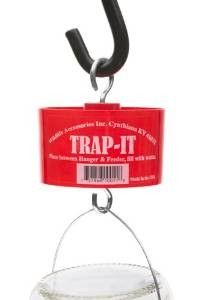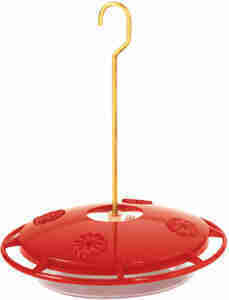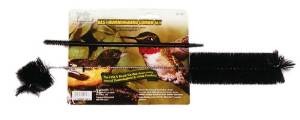The best way to control pets at the Hummingbird Feeder is to use a good quality feeder that has pest control built right into the feeder, like the HummZinger hummingbird feeder. Check them out by following the link below.
Go to the Hummzinger Hummingbird Feeder Store
Here you will learn how to keep bees away from your hummingbird feeder and how to ant proof your hummingbird feeder. Also how to make hummingbird nectar and how to clean your hummingbird feeder. These are all essential for you to have the best possible hummingbird feeding experience!
Warning, it tickles!
And as an added bonus, at the end of this article is my special instructional video that will show you how to quickly teach your hummingbirds to feed out of your bare hand.
Learning how to keep bees away from your feeder and how to ant proof your hummingbird feeder is possible with a few simple techniques and even easier if you start with a hummingbird feeder with built-in features to keep out bees, ants, wasps and other insects.
The sugar solution will also be attractive to ants, bees and wasps.
Not only will they drink, they will also contaminate the nectar and sometimes even keep the hummingbirds from using the feeder. Keeping ants out of hummingbird feeder is important because they will get inside the feeder, where they will drown and contaminate the nectar as their bodies decompose.
I have seen bees and wasps at my feeder so thick that the hummingbirds couldn’t feed at all. Thumping them with a rolled up newspaper seemed to help a little, but every time I thumped one, it wasn’t long before it was replaced by another.
Besides being a little too risky …. after a while, keeping bees off the feeder by thumping them with a newspaper begins to take a toll on your feeder! So, let’s examine some alternative possibilities for keeping your hummingbird feeder, insect free.
Click on the link to learn more about other critters you might want to keep out of your feeder.
How do you keep ants out of a hummingbird feeders?
Drip proof feeder
- One solution is to keep the ants from finding your Hummingbird feeder in the first place ….. Using a drip proof feeder is one way to help keep the ants from locating your Hummingbird feeder.
There are basically 2 types of feeders, bottle-type feeders and saucer-type hummingbird feeders. Bottle-type feeders have a tendency to drip. When the air that’s trapped above the nectar heats up, it expands and forces the nectar out through the feeding ports. Basin or saucer-type feeders are designed so that they are less likely to drip. Once a feeder starts drip, the nectar will collect on the outside of the feeder and also on the ground. Ants seem to be very good at locating the source of the nectar.
Use an ant moat
2. Another answer is to keep the ants away from the Hummingbird nectar. Okay, the ants have found your feeder, go to plan b. The best way to keep ants out of the feeder is to keep ants away from the nectar by using some sort of “ant guard” or ant moat. An ant guard is a barrier that’s placed between the ants and the Hummingbird nectar. These ant guards are built into some feeders in the form of an ant moat that can be filled with water to keep the ants away from the nectar.
But the moats can also be purchase separately and added to a feeder. The ant moats usually consist of a plastic cup about 3 inches in diameter. The moat is hung between the feeder hook, or whatever you hang your feeder with, and the feeder itself. Because ants can’t swim, once the ant moat is filled with water the ants can’t get to the nectar. Now your feeder ant problem is solved.
Will Vaseline keep ants off a hummingbird feeder?
Some people recommend putting vaseline on the hanger of the feeder to keep ants off of a hummingbird feeder. While Vaseline (petroleum jelly) can temporarily deter ants from climbing onto a hummingbird feeder, experts strongly advise against using it as it can be harmful to hummingbirds. If they come into contact with the grease, it can coat their feathers and impair their ability to fly properly, potentially causing them harm or even death.
Ant moat for a hummingbird feeder

Using Ant moats for hummingbird feeders is the best way to protect your Hummingbird feeder from ants and other crawling insects. Simply insert the ant moat between the feeder hanger and the feeder and fill with water.
Ant moats are mostly made of plastic and metal and come in a variety of designs that will complement any hummingbird feeder. And should you choose a red ant moat, it will greatly add to the attraction of your feeder to hummingbirds.
Do it yourself ant moat for hummingbird feeders
If you want to try, here is a do it yourself ant moat project that uses the plastic cap from a spray can. Punch or drill a hole in the cap to run the feeder hanger wire through, then use hot glue or silicone sealant to seal the hole and make the lid water proof so you can fill it with water.
Below is a great video that demonstrates another way to make an ant moat.
Keep bees from hummingbird feeder
There are 4 ways to answer the problem of how to keep bees away from a hummingbird feeder.
!. Keep bees from a hummingbird feeder by buying a feeder with bee guards. Some Hummingbird feeders come equipped with plastic mesh bee guards. Unfortunately, a lot of these Hummingbird feeders will also be prone to dripping which will undermine the effectiveness of the bee guards.
2. Try moving the feeder to keep bees from hummingbird feeder. Sometimes just moving the Hummingbird feeder a few feet will trick the insects into thinking that it’s gone and they won’t find it. If your insects happen to be too smart to fall for this one….. try taking the feeder down for a day or two until they quit looking for it. The Hummingbirds won’t give up as quick as the insects, so once you hang it back up the Hummingbirds will find it again.
3. To keep bees from hummingbird feeder try giving the insects their own feeder. Personally, I would rather go back to thumping them with a rolled up newspaper before I conceded and tried this trick, but it’s a technique used effectively by lots of people, so I thought it appropriate to mention here.
You will need two Hummingbird feeders, one for the bees and wasps and one for the Hummingbirds. Bees and wasps are more attracted to higher concentrations of sugar, so in their feeder use a nectar ratio of 1 part sugar to 3 parts water. In the Hummingbirds feeder, instead of using the standard 1 to 4 ratio, use a ratio of 1 part sugar to 5 parts water. This ratio although not as sweet as the 1 to 4, will still be good enough for the Hummingbirds, but not nearly as attractive to the bees and wasps as the feeder with the 1 to 3 ratio.
Give the bees and wasps a few hours to attach themselves to their feeder then move it away from the Hummingbird feeder and hope they follow.
4. The best way to keep bees away from a hummingbird feeder is to invest in good hummingbird feeder that is designed to keep bees and other insects away from the hummingbird nectar.
What is the best hummingbird feeder?
OK, so you want to get the best insect-proof feeder you can find with all the latest bells and whistles, that will attract hordes of hummingbirds and let them feed in peace? Here’s what a good hummingbird feeder will look like.
- It will be a non-leaking, basin type feeder
2. The feeder will be red in color to attract hummingbirds
3.It will come with a built-in ant moat, or have an add on moat, to keep ants out of your hummingbird nectar
4.There will be some type of bee guards to keep bees from reaching the nectar. The most common are the yellow bee guards you see that fit over the feeding ports. Since bees and wasps are attracted to the color yellow, let’s go with something else. The best hummingbird feeders have patented “Nectar Guard Tips”. These are flexible plastic membranes that fit into the feeding ports from the underside of the top of the feeder. The hummingbird can insert it’s long bill down through the nectar guard tips to feed and when it withdraws it’s beak, the tips close back up and keep out bees and wasps.
5.The feeder with have built-in perches for the hummingbirds to sit on while they feed. This will help the birds conserve energy and will give you a better view of the birds.
6.It will be easy to take apart and clean. A clean hummingbird feeder is a must if you want to attract and keep birds coming back to your feeder. A clean feeder is also important for the health of the hummingbirds.
7.The best feeder will also have a rain guard that will keep rain water from running into the feeder and diluting your nectar. This is accomplished by having a raised flower around the ports. Red flowers, not yellow.
There you have it in a nutshell. Just find a non-leaking hummingbird feeder with all these features! There are a few feeders that have them all, the HummZinger line of hummingbird feeders.
Here is the best way to keep bees from a hummingbird feeder and to ant proof a hummingbird feeder

Aspects 12oz Humzinger Ultra With Nectar Guard
Here’s a video about the HummZinger ant and bee proof feeder
You can see the raised flowers around the feeding ports that keep out rain water and notice they are red, not yellow. You can see the ant moat around the hanger, but you don’t see any ants on the feeder or crawling up and down the feeder. They don’t waste time where there is no food to be had.
At about the 2:35 mark, notice the bee checking out the feeding ports. The bee is not able to reach the nectar. The level of the nectar solution is way below the top of the feeder where only hummingbirds with their extremely long tongues can reach it. So, the bee leaves. Notice the hummingbirds are all smiling! 🙂
If you have an existing feeder that you want to bee-proof, check out the video below.
Here’s a video on how to bee proof your hummingbird feeder with plastic mesh from an onion sack.
How to make homemade hummingbird nectar
Now that you have a good feeder that’s ant and bee proof, you will need some hummingbird food to put into your feeder. Hummingbird nectar is easy and cheap to make so you might as well make your own and save money in the process. I forgot to mention, it’s fun too!
Homemade hummingbird nectar recipe
The homemade hummingbird food recipe only contains 2 simple ingredients, tap water and granulated table sugar, the same sugar you put in your cereal each morning. That’s it, DON”T put any other kind of sweeteners into it. And DON”T use red food coloring. Food coloring is harmful to hummingbirds! The only reason it’s used is because hummingbirds are attracted to the color red. If you have a red feeder or a red ant moat, that’s enough red. Or you can tie red ribbons on your feeder.
Here’s the ratio of sugar to water that is used in homemade hummingbird food.
1 part sugar to 4 parts water
This ratio will yield a mixture that is similar to the flower nectar that hummingbirds feed on.
First, put a pan on the stove and add 4 parts of water. For this example we will be using cups. So add 4 cups of water to the pan. While the water comes to a boil, stir in 1 cup of sugar and continue to stir until the sugar is dissolved. Boil the mixture for 2 minutes. Boiling the mixture will release the chlorine and kill any mold spores or bacteria that might be in the sugar. This will keep your nectar fresh for a longer period after it added to the feeder and put outside.
Don’t boil any longer than 2 minutes or too much of the water will be evaporated and the mixture will be sweeter. A sweeter mixture is more attractive to bees and wasps so we want to avoid this. After 2 minutes remove the nectar from the stove and let it cool. Once it’s cool you can add it to your feeder. Any nectar you have left you can store in the refrigerator for up to 2 weeks and use when needed.
Here is a video on how to make homemade hummingbird food
When do you have to change the hummingbird nectar?
You will have to change the nectar in the feeder every so often before the nectar ferments and gets moldy. The temperature of the air outside will determine how long the hummingbird food will keep before it ferments. The hotter the temperatures, the more often the nectar will have to be changed. Below is a general guide line you can follow. You’ll have to allow for where you hang your feeder, in the shade or in the sun. When the nectar starts to become cloudy, it needs to be changed. Changing it a little sooner, before it starts to go bad is best.
High temperatures…………Change nectar after
71-75……………………………6 days
76-80……………………………5 days
81-84……………………………4 days
85-88……………………………3 days
89-92……………………………2 days
93+………………………………change daily
Each time you change the hummingbird food, rinse out your feeder with hot water several times before refilling. The National Audubon Society suggests that you clean your feeder about once a week. They say to rinse the feeder with 1 part white vinegar and 4 parts water. Then rinse your feeder 3 times with clear warm water before refilling.
Should you not change your nectar soon enough and black spots of mold grow in the nectar and on your feeder,you will have to give it a thorough cleaning to kill the mold and sterilize the feeder. To kill the mold, soak your feeder in a mild bleach solution containing 1/4 cup bleach to 1 gallon of water. Soak the feeder in this solution for an hour.
Hummingbird feeder brushes
You may need to use some small hummingbird feeder cleaning brushes to get out all the mold. Once the feeder is done soaking, rinse it several times to remove all traces of the bleach so it doesn’t harm your hummingbirds.

A good set of small hummingbird feeder brushes is invaluable, when it comes to cleaning a hummingbird feeder. Mold and dirt can build up quickly and can be harmful. Brushes are great for stubborn spots and hard to reach areas. Brushes clean the stems or opening of the feeder flowers and the sides and bottom of the nectar bottles.
Here is a good video on cleaning a hummingbird feeder.
ADDED BONUS: 🎉 Unlock the Secret to Hand-Feeding Hummingbirds! 🦋🌸
In this thrilling instructional video, you’ll discover the magical art of hand-feeding your hummingbirds! 🌟 Watch as these tiny, vibrant creatures hover just inches away from you, sipping nectar straight from your hand! 👐✨
This step-by-step guide will show you:
- The essential tips and tricks to attract these fascinating little birds to your hand 🕊️
- The perfect nectar recipes 🍯
- How to build trust and create an unforgettable experience 🤝
Prepare to be amazed as you witness the beauty and grace of hummingbirds up close, and feel the joy of connecting with nature in the most extraordinary way! 🌈🌿
Don’t miss out on this unbelievable opportunity to bring nature right to your fingertips! 🌸
Here’s an exciting twist! Imagine this: you can hand-feed hummingbirds right through the window of your home with a technique that feels like pure magic. Picture yourself standing still, palm outstretched, with tiny, shimmering wings buzzing just inches away as these fearless little creatures come to feed from the nectar you’ve prepared. It’s a breathtaking, intimate experience that brings you closer to nature in a way few people ever get to experience. Ready to make that happen? Let’s dive into the steps!
If you would like to watch my other videos on hand-feeding different backyard birds and squirrels, click the link Hand-feeding backyard birds and squirrels
Now you have learned how to make homemade hummingbird food, how to keep the nectar fresh and how to clean your feeder. You’ve also learned how to keep bees and ants off of your hummingbird feeder and even how to hand-feed your hummingbirds.
With all that knowledge you shouldn’t have any trouble attracting hummingbirds to your yard and keep them coming back again and again for that delicious homemade nectar! Enjoy your hummingbirds!
If you found this article helpful please share it with your friends using the social bookmarking buttons on the left side of this page. Help everyone to increase their enjoyment of feeding hummingbirds. Do it for the hummingbirds!

